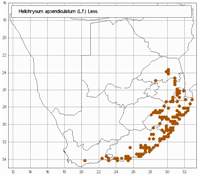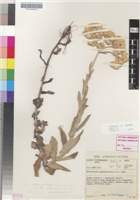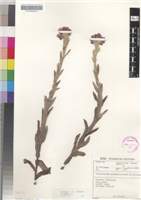Common names:
Sheep�s ears, skaapoorbossie sewejaartjie (A), senkontoana (SS), ibode (Z)
Origin of name:
appendiculatus / -a / -um = with appendages
Diagnostic characters:
Woolly leaves
Open or closed branched inflorescence
Large heads
Description:
Perennial herb, stock thick, woody, flowering stems 1 or several from the crown, up to c. 550 mm tall, simple or occasionally forked, thinly greyish woolly, closely leafy throughout. Radical leaves up to 80 x 20 mm, spreading, elliptic-oblong, apex acute, base broad, clasping, both surfaces woolly; cauline leaves smaller, diminishing in size upwards, lanceolate-oblong to lanceolate, apex acute, uppermost tipped with a small scarious bract, base broad, half-clasping, very shortly decurrent, upper surface grey-woolly, at least initially, often glandular-hispid, or nearly glabrous with age, lower surface grey-woolly. Heads homogamous, campanulate, (6�) 7�14 mm long, many in corymbose clusters arranged in a compact or open corymbose panicle. Involucral bracts in c. 6 series, graded, loosely imbricate, inner equaling or exceeding flowers, tips radiating, acute to acuminate, often squarrose, dull, creamy white or yellowish often washed brown, purplish or crimson. Receptacle with fimbrils at least equaling the ovaries. Flowers 28�58, yellow. Achenes 1 mm long, barrel-shaped, glabrous. Pappus bristles many, about equaling corolla, scabrid, bases cohering strongly by patent cilia.
Flowering mainly between December and February.
Distribution:
Grows in grassland, or in short fynbos in the southern Cape. Ranges from the E. highlands of Mpumalanga and western Swaziland to the NE. mountainous corner of the Free State and nearby Leribe in Lesotho, KwaZulu-Natal from near sea level to c. 2 100 m, Transkei, and the Cape mountains as far west as Swellendam.
Savanna, Grassland, Thicket and Fynbos Biomes.
Notes:
There is much variation in the degree of woolliness of the upper leaf surface and in the degree to which the tips of involucral bracts are produced and recurved. The typical plant has leaves woolly on both surfaces and acute involucral bracts that were probably pale yellow, the outermost reddish (the bracts have faded); the types of H. lupulaceum and H. folliculatum are similar and the bracts are clearly pale yellow with some red outside, while that of G, humile has concolorous woolly leaves and acuminate crimson bracts. The type of H. discolor has discolorous leaves (wool lacking above) and yellow acuminate bracts. Variation is continuous and cannot be partitioned satisfactorily. However, H. appendiculatum is easily distinguished from its allies by its dull, not glossy, involucral bracts.
Taxonomy:
Literature:
Helichrysum appendiculatum (L.f.) Less., Syn.Comp. 308 (1832); DC., Prodr. 6: 208 (1838); Harv. in F.C. 3: 242 (1865); Moeser in Bot. Jb. 44: 318 (1910); Compton, Fl. Swaziland 628 (1976); Hilliard, Compositae in Natal 183 (1977).
Type:
Lectotype: Cape of Good Hope, Thunberg (sheet 19095, UPS).
Synonym(s):
Gnaphalium appendiculatum L.f., Suppl. 363 (1781).
G. lupulaceum Lam., Encycl. 2: 752 (1788). Type: Cape of Good Hope (P-LAM).
G. humile Thunb., Prodr. 151 (1800), Fl. Cap. 655 (1823).
Helichrysum appendiculatum var. humile (Thunb.) DC., Prodr. 6: 209 (1838). Type: Cape of Good Hope, Thunberg (sheet 19177, UPS, holo.).
Helichrysum folliculatum DC., Prodr. 6: 197 (1838).
Gnaphalium folliculatum (DC.) Sch. Bip. in Bot. Ztg 3: 171 (1845). Lectotype: Cape, not far from the Kowie River, Burchell 4145 (G-DC; K, isolecto.).
H. folliculatum var. purpurascens DC., Prodr. 6.: 197 (1838). Type: Eastern Cape, Winterberg, highest mountain between Tarka and Katberg, 5 000�6 000 ft, Ecklon 1320 (G-DC, holo.).
H. discolor DC., Prodr. 6: 197 (1838).
Gnaphalium discolor (DC.) Sch. Bip. in Bot. Ztg 3: 172 (1845).
H. appendiculatum var. discolor (DC.) Harv. in F.C. 3: 242 (1865). Type: KwaZulu-Natal, between the Umzimkulu River and Port Natal, Dr�ge 5016 (G-DC, holo.).
Vouchers:
Codd 2794 (NU; PRE); 24917 (NBG); Devenish 1629 (E; K; NU; S); Hilliard & Burtt 10982 (E; K; M; MO; NU; PRE; S); MacOwan 739 (BOL; SAM); Tyson 1501 (SAM); Wright 449 (E; K; M; NH; NU).

_sml.jpg)
_sml.jpg)
_sml.jpg)
_sml.jpg)

